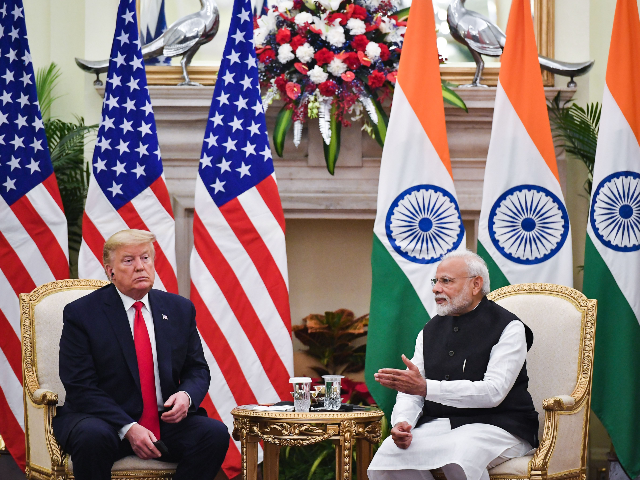President Donald Trump blatantly dodged the public pressure by Indians for more H-1B visas, so indicating that he is concerned that his administration’s support for white-collar visa workers will alienate the U.S. college graduate voters he will need in 2020.
“We’re talking about the H1-Bs,” Trump told an Indian journalist at a February 25 press conference in India. Trump continued by changing the topic:
We are, and look the relationship we have, this is not from me, this is from almost everybody. They say the history of India, which has a long history and a brilliant history in so many different ways, there has never been a reception given to somebody like was given and I would like to say for the United States of America, but nobody else that came here got the kind of reception we got.
Behind closed doors, the Indian government also pressed Trump to support the H-1B and Optional Practical Training programs that deliver nearly all of the roughly 1 million Indian contract-workers into U.S. jobs.
“From our side, the issue of H-1B visa was raised. It was pointed that Indian professionals contribute significantly to the development of [the] high-tech sector in the United States,” foreign minister Harsh Shringla told reporters at an Indian press conference. The Hindustan Times reported:
Noting that there are about 200,000 Indian students currently studying in the United States, Shringla said that the two sides discussed that the “area of education is also covered in the people-to-people relationship.”
“There was a realisation that there is a vibrant Indian community in the United States, who contribute significantly, both, to the economy and society. At the same time, it was important that the area of education is also covered in the people-to-people relationship,” he said.
But the vast majority of the Indian workforce in the United States are lower-skilled contract workers who have been used by executives to replace well-paid American professionals in technology, accounting, science, and design jobs.
Also, India’s visa workers have been used to export many additional white-collar jobs back to India, helping to freeze wages for U.S. college graduates nationwide.
This economic damage is ignored by the establishment media and by Congress. But it has prompted Americans professionals to create several advocacy groups, including SAITJ.org, U.S. Tech Workers, and the American Workers Coalition. The groups are vigorously protesting the administration’s failure to protect Americans workers from the H-1B program, creating a potential suburban-voter problem for the 2020 election.
In March 2016, after much zig-zagging, Trump declared:
The H-1B program is neither high-skilled nor immigration: these are temporary foreign workers, imported from abroad, for the explicit purpose of substituting for American workers at lower pay. I remain totally committed to eliminating rampant, widespread H-1B abuse and ending outrageous practices such as those that occurred at Disney in Florida when Americans were forced to train their foreign replacements. I will end forever the use of the H-1B as a cheap labor program, and institute an absolute requirement to hire American workers for every visa and immigration program. No exceptions.
But in January 2020, Trump defended the visa-worker programs in an interview with Fox News’ Laura Ingraham:
“We have to allow smart people to stay in our country — if you graduate number one in your class at Harvard, [if] you graduate from the Wharton School of Finance,” Trump said. “If we tell smart people to get the hell out, that’s not America first.”
“Yes, that’s a small percentage of what [companies] want,” said Ingraham.
”No, it’s not. It’s a lot,” said Trump.
“You ran on people training their foreign replacements, that you ran against that. It’s humiliating for an American worker who works for a company for 30 years … to train your replacement,” Ingraham said.
“No, no, that’s different, I would never do that,” said Trump.
“Why shouldn’t we have American graduates of colleges and universities taking those jobs? Ingraham said.
“We do,” answered Trump. “But we don’t have enough of them … and we have to be competitive with the rest of the world too.”
India sees the Indian workforce in the United States as vital to the nation’s economic development. “The flow of talent is part of our economic cooperation,” India’s External Affairs Minister Subrahmanyam Jaishankar said in December 2019:
It is in a sense almost strategic bridge between us. So, I cannot overstate the importance of the flow of talent for Indo-American ties. That was a point I make that look, this is important for you, it is important for us. It’s important for the relationship. So let’s work together to make sure this stays sort of open and vibrant and active.
The imported Indian workforce may also be slowing U.S. technology development. For example, China’s 5G technology has surpassed similar technology developed by U.S. companies — and their huge Indian workforce in Silicon Valley.
Business groups strongly back the imported Indian workforce of roughly 1 million graduates. The support is based on Indian promises of cost savings — which may not be realized because of Indian-style workplace inefficiencies. U.S. managers also value the Indian workforce because the Indians are less likely to leave for rival companies.
However, U.S.-based Indian managers at U.S. companies may have different incentives. Numerous reports say Indian managers hire Indian workers who reportedly will pay kickbacks in exchange for getting the jobs, despite federal laws and EEO regulations against discrimination.

COMMENTS
Please let us know if you're having issues with commenting.